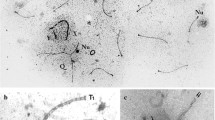Abstract
Two paracentric inversions in the mouse, In(1)1 Rk and In(2)5 Rk, have been studied in surface microspreads of spermatocytes from heterozygotes. At zytogene, synaptic initiation occurs independently in three regions: within the inversion, and without, on either side. Synaptonemal complex (SC) formation is restricted to homologous regions, resulting in inversion loops in all early pachytene spermatocytes. An adjusting phase then occurs during pachytene in which the inversion loop is reduced by desynapsis of homologously synapsed SC, followed immediately by non-homologous synapsis with the alternate pairing partner, progressing from the ends toward the middle. Adjustment occurs during the first half of pachytene, but is not closely synchronized with sub-stage. It is complete by late pachytene, the loop having been eliminated in all cases and replaced by “straight” SCs in which the inverted region is heterosynapsed. Synapsis in the adjustment phase is evidently permitted only after the homosynaptic phase, and is indifferent to homology. It may lead to heterosynapsis, as in the inversion region, or to synapsis of homologous regions not synapsed at zytogene. The anaphase bridge frequency, a measure of crossing over within the inversion, is about 34% for both inversions studied, indicating that such crossovers do not block adjustment, that crossing over probably occurs before or during the adjustment period, and that there is some crossover suppression. The last could be the consequence of blocking by desynapsis/heterosynapsis. Synaptic adjustment appears to be a general phenomenon that occurs to varying extents in different forms. A hypothetical scheme for two phases of synapsis is proposed: at zytogene, a basic propensity for indifferent SC formation is limited by a restricting condition to synapsis between homologous regions. Subsequently, the restriction is lifted, whereupon synaptic instability is resolved by desynapsis, followed by resynapsis that is indifferent to homology, but that results in a topologically more stable structure.
Similar content being viewed by others
References
Ashley, T., Moses. M.J., Solari, A.J.: Fine structure and behavior of a pericentric inversion in the sand rat (Psammomys obesus). J. Cell. Sci. (1981)
Comings, D.E., Okada, T.A.: Fine structure of the synaptonemal complex. Regular and stereo electron microscopy of deoxyribonuclease-treated whole mount preparations. Exp. Cell Res. 65, 104–116 (1971)
Dresser, M.E., Moses, M.J.: Silver-staining of synaptonemal complexes in surface spreads for light and electron microscopy. Exp. Cell. Res. 121, 416–419 (1979)
Gillies, C.B.: The nature and extent of synaptonemal complex formation in haploid barley. Chromosoma (Berl.) 48, 441–453 (1974)
Hotta, Y., Chandley, A.C., Stern, H.: Biochemical analysis of meiosis in the male mouse. II. DNA metabolism at pachytene. Chromosoma (Berl.) 62, 255–268 (1977)
Maguire, M.P.: The temporal sequence of synaptic initiation, crossing over and synaptic completion. Genetics 70, 353–370 (1972)
Maguire, M.P.: A search for the synaptic adjustment phenomenon in maize. Chromosoma (Berl.) 81, 717–725 (1981)
Martin, J.: Meiosis in inversion heterozygotes in Chironomidae. Canad. J. Genet. Cytol. 9, 255–268 (1967)
McClintock, B.: The association of nonhomologous parts of chromosomes in the mid-prophase of meiosis in Zea mays. Z. Zellforsch. 19, 191–233 (1933)
Moses, M.J.: Microspreading and the synaptonemal complex in cytogenetic studies. Chromosomes today 6, 71–82 (1977)
Moses, M.J.: New cytogenetic studies on mammalian meiosis. In: Animal Models in Human Reproduction (M. Serio, ed.). New York: Raven Press 1980
Moses, M.J., Karatsis, P.A., Hamilton, A.E.: Synaptonemal complex analysis of heteromorphic trivalents in Lemur hybrids. Chromosoma (Berl.) 70, 141–160 (1979)
Moses, M.J., Poorman, P.A.: Synaptonemal complex analysis of mouse chromosomal rearrangements. II. Synaptic adjustment in a tandem duplication. Chromosoma (Berl.) 81, 519–535 (1981)
Moses, M.J., Poorman, P.A., Russell, L.B., Cacheiro, N.L., Roderick, T.H., Davisson, M.T.: Synaptic adjustment: two pairing phases in meiosis. J. Cell Biol. 79, 123a (1978)
Novitski, E., Braver, G.: An analysis of crossing over within a heterozygous inversion in Drosophila melanogaster. Genetics 39, 197–209 (1954)
Nur, U.: Synapsis and crossing over within a paracentric inversion in the grasshopper Camnula pellucida. Chromosoma (Berl.) 25, 198–214 (1968)
Poorman, P.A., Moses, M.J., Russell, L.B., Cacheiro, N.L.A.: Synaptonemal complex analysis of mouse chromosomal rearrangements. I. A tandem duplication. Chromosoma (Berl.) 81, 507–518 (1981a)
Poorman, P.A., Moses, M.J., Davisson, M.T., Roderick, T.H.: Synaptonemal complex analysis of mouse chromosomal rearrangements. III. Cytogenetic observations on two paracentric inversions. Chromosoma (Berl.) 83, 419–429 (1981b)
Rasmussen, S.W.: Chromosome pairing in triploid females of Bombyx mori analayzed by three dimenional reconstructions of synaptonemal complexes. Carlsberg Res. Commun. 42, 163–197 (1977)
Rasmussen, S.W., Holm, P.B.: Chromosome pairing in autotetraploid bombyx females. Mechanism for exclusive bivalent formation. Carlsberg Res. Commun. 44, 101–125 (1979)
Rattner, J.B., Goldsmith, M.R., Hamkalo, B.A.: Chromosome organization during male meiosis in Bombyx mori. Chromosoma (Berl.) 82, 341–351 (1981)
Roderick, T.H., Hawes, N.L.: Nineteen paracentric chromosomal inversions in mice. Genetics 76, 109–117 (1974)
Stern, H., Hotta, Y.: Regulatory mechanism in meiotic crossing over. Ann. Rev. Plant Physiol. 29, 415–436 (1978)
Author information
Authors and Affiliations
Rights and permissions
About this article
Cite this article
Moses, M.J., Poorman, P.A., Roderick, T.H. et al. Synaptonemal complex analysis of mouse chromosomal rearrangements. Chromosoma 84, 457–474 (1982). https://doi.org/10.1007/BF00292848
Received:
Issue Date:
DOI: https://doi.org/10.1007/BF00292848




